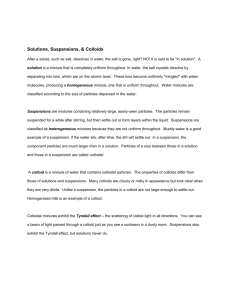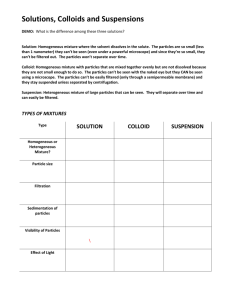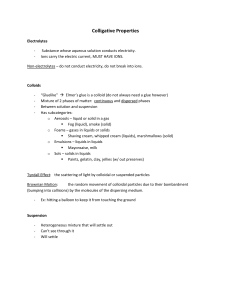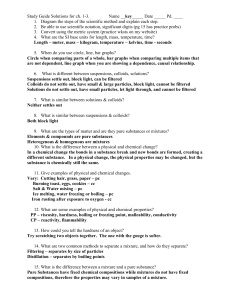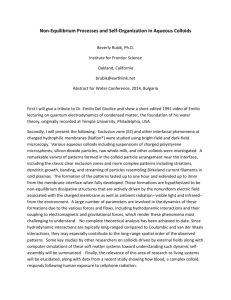Name
advertisement
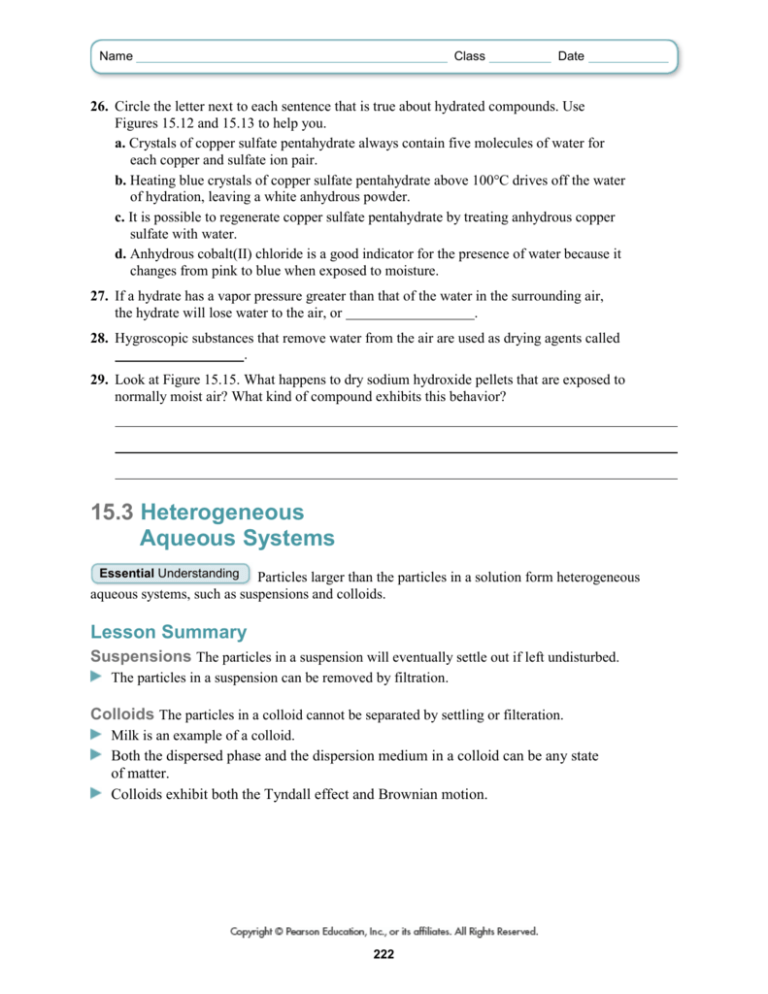
Name Class Date 26. Circle the letter next to each sentence that is true about hydrated compounds. Use Figures 15.12 and 15.13 to help you. a. Crystals of copper sulfate pentahydrate always contain five molecules of water for each copper and sulfate ion pair. b. Heating blue crystals of copper sulfate pentahydrate above 100°C drives off the water of hydration, leaving a white anhydrous powder. c. It is possible to regenerate copper sulfate pentahydrate by treating anhydrous copper sulfate with water. d. Anhydrous cobalt(II) chloride is a good indicator for the presence of water because it changes from pink to blue when exposed to moisture. 27. If a hydrate has a vapor pressure greater than that of the water in the surrounding air, the hydrate will lose water to the air, or . 28. Hygroscopic substances that remove water from the air are used as drying agents called . 29. Look at Figure 15.15. What happens to dry sodium hydroxide pellets that are exposed to normally moist air? What kind of compound exhibits this behavior? 15.3 Heterogeneous Aqueous Systems Essential Understanding Particles larger than the particles in a solution form heterogeneous aqueous systems, such as suspensions and colloids. Lesson Summary Suspensions The particles in a suspension will eventually settle out if left undisturbed. The particles in a suspension can be removed by filtration. Colloids The particles in a colloid cannot be separated by settling or filteration. Milk is an example of a colloid. Both the dispersed phase and the dispersion medium in a colloid can be any state of matter. Colloids exhibit both the Tyndall effect and Brownian motion. 222 Name Class Date After reading Lesson 15.3, answer the following questions. Suspensions 1. Is the following sentence true or false? Heterogeneous mixtures are not true solutions. 2. Heterogeneous mixtures in which particles settle out upon standing are called . 3. Is the following sentence true or false? When a suspension of clay particles in water is filtered, both clay and water will pass through the filter paper. Colloids 4. Heterogeneous mixtures in which particles are of intermediate size between those of true solutions and suspensions are called . 5. The scattering of light in all directions by colloidal particles is known as the . 6. Identify each type of system shown in the figure below. A student is examining three different aqueous systems. a. From what you know about aqueous systems, explain how the student can decide which sample is a solution, which is a suspension, and which is a colloid. b. Sequence solution, suspension, and colloid according to how much the polarity of water molecules affects the particles in the system. Explain your answer. 223 Name Class Date 15 Self-Check Activity For Questions 1–8, complete each statement by writing the correct word or words. If you need help, you can go online. 15.1 Water and Its Properties 1. Many of the unique properties of water result from the between water molecules. bonding 2. The unique properties of water include its low surface tension and boiling point. and its high 3. Both liquid water and solid water have hydrogen bonds, but in solid water, they form a(n) arrangement. 15.2 Homogeneous Aqueous Systems 4. compounds and polar covalent compounds dissolve most readily in water. 5. Because all ionic compounds form ions, all ionic compounds are . 6. The water molecules in held in place by weak bonds. are easily gained or lost because they are 15.3 Heterogeneous Aqueous Systems 7. The particles in a(n) time. are relatively large and will settle out over 8. contain particles smaller than those in suspensions but larger than those in solutions. If You Have Trouble With… Question 1 2 3 4 5 6 7 8 See Page 489 490 492 494 496 498 504 505 224 Name Class Date Review Key Equations From the choices below, write in each box the term that correctly completes the equation. mass of water percent by mass H2O = mass of hydrate × 100% EXTENSION Choose a hydrate from Table 15.2 and find its percent by mass H2O. Review Vocabulary Answer the following questions. 1. Use the terms weak electrolyte, electrolyte, nonelectrolyte, and strong electrolyte to complete this diagram. Greatest number of ions No ions 2. Complete the following paragraph with vocabulary terms from Lesson 15.2. Sheryl was working with a sample of MgSO4 · 7H2O in the lab. She knew the compound was a(n) because it contained water molecules in its formula. She placed the compound in a test tube and heated it, driving off the . The resulting compound was . Because this compound is now , which means it absorbs water from its environment, it could be used as a(n) to remove water from other compounds. 3. Sequence the following terms according to the size of the particles they contain, from smallest to largest: colloid, solution, suspension. 225

